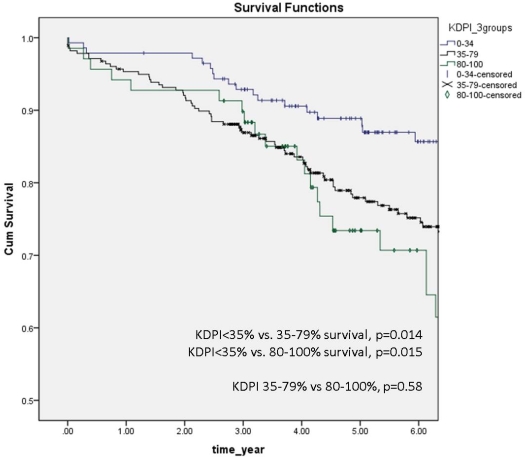Optimal Donor/Recipient Pairing for High KDPI Grafts Can Yield Similar Survival to Medium KDPI Grafts.
Medical College of Wisconsin, Milwaukee.
Meeting: 2016 American Transplant Congress
Abstract number: 317
Keywords: Kidney transplantation, Outcome
Session Information
Session Name: Concurrent Session: Kidney Transplant Recipient: Long Term Outcomes Session I
Session Type: Concurrent Session
Date: Monday, June 13, 2016
Session Time: 4:30pm-6:00pm
 Presentation Time: 5:42pm-5:54pm
Presentation Time: 5:42pm-5:54pm
Location: Veterans Auditorium
KDPI is a predictor of deceased-donor (DD) graft survival, calculated using donor factors. It does not consider recipient or other post-procurement factors. This retrospective analysis reviews historical outcomes of high KDPI organs (>80%) at our center.
490 adult DD kidney-alone transplants performed at our center between 2005 and 2012 were retrospectively analyzed. Follow up median time was 5.3 years (Range 0-10.5).
142 KDPI <35% grafts were transplanted, 279 with KDPI 35-79% and 69 with KDPI>80%. 1, 3 and 5 year graft survival rates (with 95% confidence intervals) for high KDPI kidneys were 94% (85-97), 89% (81-94) and 73% (60-84) exceeding UNOS published data (85%, 71% and 57% respectively for KDPI of 85).The difference in survival for the KDPI 35-79% and >80% groups was statistically non-significant, p=0.58. KDPI>80% group had more older male recipients.
KDPI>80% group had more older male recipients.
| High KDPI (80-100%) (n=69) |
Medium KDPI (35-79%) (n=279) |
p Value | |
| Age (years, mean±SD) | 57±10.9 | 51±12.1 | 0.0006 |
| Male | 72.5% | 59.1% | 0.04 |
| African-American | 46.4% | 37.6% | 0.18 |
| Diabetes (recipient) | 37.7% | 34.8% | 0.65 |
| Cold Ischemia Time (hour, mean±SD) | 15±5.6 | 16±5.9 | 0.24 |
| Import | 8.7% | 16.8% | 0.09 |
| Pumped | 44.9% | 33.3% | 0.07 |
| Delayed graft function | 17.4% | 16.8% | 0.91 |
| Acute rejection during first year | 20.3% | 14% | 0.19 |
| Table 1. Recipient Charecteristics. High KDPI group (>80) vs. Medium KDPI group (35-79%) | |||
Univariate analysis showed significantly worse outcomes for African-American (AA) recipients in KDPI 35-79% and >80% groups (p=0.011 and 0.002 respectively) with no significant difference in the <35% group (p=0.71). Diabetes was associated with worse outcomes in all groups (p<0.001). Cox multivariate analysis for graft loss in KDPI>80 showed AA Hazard ratio 4.3 and pump HR 0.3.
| HR | p Value | 95% CI | |
| African-American Recipient | 4.3 | 0.006 | 1.5-12.5 |
| Pump | 0.3 | 0.03 | 0.1-0.9 |
| Table 2. Cox multivariate analysis for all cause graft loss in KDPI > 80% group. | |||
Our results suggest high KDPI grafts can have similar outcomes to medium KDPI with use of pump preservation and minimizing use in high risk recipients(diabetics, AA, highly sensitized and retransplants).
CITATION INFORMATION: Selim M, Saad E, Zimmerman M, Johnson C. Optimal Donor/Recipient Pairing for High KDPI Grafts Can Yield Similar Survival to Medium KDPI Grafts. Am J Transplant. 2016;16 (suppl 3).
To cite this abstract in AMA style:
Selim M, Saad E, Zimmerman M, Johnson C. Optimal Donor/Recipient Pairing for High KDPI Grafts Can Yield Similar Survival to Medium KDPI Grafts. [abstract]. Am J Transplant. 2016; 16 (suppl 3). https://atcmeetingabstracts.com/abstract/optimal-donorrecipient-pairing-for-high-kdpi-grafts-can-yield-similar-survival-to-medium-kdpi-grafts/. Accessed July 5, 2025.« Back to 2016 American Transplant Congress
